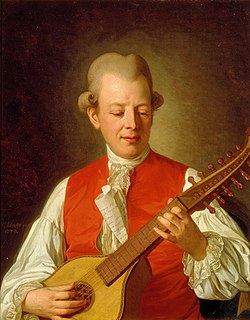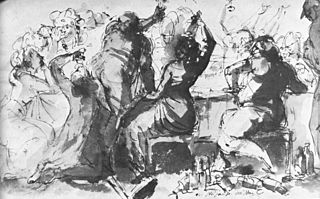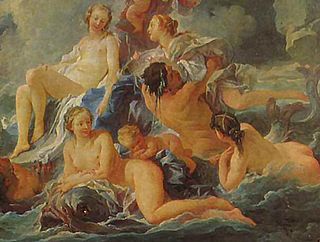 W
WCarl Michael Bellman was a Swedish songwriter, composer, musician, poet and entertainer. He is a central figure in the Swedish song tradition and remains a powerful influence in Swedish music, as well as in Scandinavian literature, to this day. He has been compared to Shakespeare, Beethoven, Mozart, and Hogarth, but his gift, using elegantly rococo classical references in comic contrast to sordid drinking and prostitution—at once regretted and celebrated in song—is unique.
 W
WAck du min moder, originally written Ach! du min Moder, is one of the Swedish poet and performer Carl Michael Bellman's best-known and best-loved songs, from his 1790 collection, Fredman's Epistles, where it is No. 23. It begins as a lament, as Jean Fredman lies drunk in a Stockholm gutter outside the Crawl-in tavern, cursing his parents for conceiving him. Then he goes in, is revived by a stiff drink, and thanks his mother and father for his life.
 W
WBacchi tempel öppnat vid en hjältes död, commonly known as Bacchi Tempel is a song play, a long poem in two thousand alexandrines, written by Carl Michael Bellman and published by Sweden's royal printing press in 1783. The illustrator was Elias Martin. The work had been preceded by a version from 1779 titled "Bacchi Temple opened at the death of Corporal and Order Oboist Father Movitz", but had been reworked and expanded several times. The work has probably never been performed in its entirety, but individual songs are sometimes performed by the Par Bricole society.
 W
WBakelse-Jeanna (1702–1788), was a Swedish pastry-seller, the name signifying "Pastry-Jeanna". She was a well known and distinctive character in Stockholm at that time, and often used as a figure within Swedish plays, songs and literature during the 18th and 19th centuries.
 W
WThe Bellman Prize is a literature prize for "an outstanding Swedish poet" awarded yearly by the Swedish Academy The prize was first established by Anders Zorn (1860-1920) and his wife Emma Lamm (1860–1942). In 1920, they had established the Emma and Anders Zorn's Donation Fund Foundation. A donation from the foundation was used to fund the Swedish Academy-Bellman Prize.
 W
WBellmansro was a restaurant north of Oakhill Palace on Djurgården island in Stockholm, which opened as a catering hall in 1828. The restaurant's eventual name reflected its proximity to Johan Niclas Byström's bust of Carl Michael Bellman that was dedicated on July 26, 1829. For much of its history Bellmansro was a tavern, but in the late 19th century it became a restaurant with food service. By the early 1900s the establishment had fallen into disrepute. The building burned to the ground May 13, 1952. An annual festival, held on Bellman Day, commemorates the inauguration of the Bellman bust.
 W
WBlåsen nu alla, "All blow now!", is one of the Swedish poet and performer Carl Michael Bellman's best-known and best-loved songs, from his 1790 collection, Fredman's Epistles, where it is No. 25. It is a pastorale, based on François Boucher's rococo 1740 painting Triumph of Venus.
 W
WBröderna fara väl vilse ibland, is one of the Swedish poet and performer Carl Michael Bellman's best-known and best-loved songs, from his 1790 collection, Fredman's Epistles, where it is No. 35.
 W
WStolta stad!, is one of the Swedish poet and performer Carl Michael Bellman's best-known and best-loved works, from his 1790 collection, Fredman's Epistles, where it is No. 33. It combines spoken sections and song. It has been described as Swedish literature's most congenial portrait of its capital city.
 W
WFader Bergström, stäm up och klinga is one of the Swedish poet and performer Carl Michael Bellman's best-known and best-loved songs, from his 1790 collection, Fredman's Epistles, where it is No. 63. The melody is based on a minuet by Carl Envallsson. Bergström was a musician, and the song celebrates dancing and drinking late into the evening.
 W
WFjäril'n vingad syns på Haga is one of the most popular of Carl Michael Bellman's collection of songs called Fredmans sånger, published in 1791, where it is No. 64. Many Swedes know the song by heart.
 W
WFred sjunger Bellman is an album by the Swedish folk singer-songwriter and guitar player Fred Åkerström and contains his interpretations of Carl Michael Bellman. The LP was released in 1969; it was re-released on CD and LP in 1990.
 W
WJean Fredman was a famous figure in 18th century Stockholm. He was the son of the watchmaker Andreas Fredman from his first marriage. He later also became a watchmaker, after being his father's apprentice. In the year 1745 he married a wealthy widow named Katarina Lindberg. Between the husband and wife there took place a buzzed-about legal process as Fredman had embezzled his wife's money.
 W
WGe rum i Bröllopsgåln din hund!, is one of the Swedish poet and performer Carl Michael Bellman's best-known and best-loved songs, from his 1790 collection, Fredman's Epistles, where it is No. 40. The song describes an utterly chaotic wedding at a venue with soldiers mixed up with musicians and the wedding-party; the chimney catches fire, and even the priest robs the collection.
 W
WGlimmande Nymf! blixtrande öga!, is one of the Swedish poet and performer Carl Michael Bellman's best-known and best-loved songs, from his 1790 collection, Fredman's Epistles, where it is No. 72. A night-piece, it depicts a Rococo muse in the Ulla Winblad mould, asleep in her bed in Stockholm, complete with allusions to both classical and Nordic mythology.
 W
WHvila vid denna källa, is one of the Swedish poet and performer Carl Michael Bellman's best-known and best-loved songs, from his 1790 collection, Fredman's Epistles, where it is No. 82. A pastoral, it depicts the Rococo muse Ulla Winblad, as the narrator offers a "little breakfast" of "red wine with burnet, and a newly-shot snipe" in the Stockholm countryside.
 W
WLiksom en Herdinna, högtids klädd, is one of the Swedish poet and performer Carl Michael Bellman's best-known and best-loved songs, from his 1790 collection, Fredman's Epistles, where it is No. 80.
 W
WMovitz! Movitz! is album by Cornelis Vreeswijk from 1977. This is another album of Vreeswijk´s interpretations of the great Stockholm troubadour, Carl Michael Bellman.
 W
WÖsterlånggatan is a street in Gamla stan, the old town of Stockholm, Sweden. Stretching southward from Slottsbacken to Järntorget, it forms a parallel street to Baggensgatan and Skeppsbron. Major sights include the statue of Saint George and the Dragon on Köpmanbrinken and the restaurant Den Gyldene Freden on number 51, established in 1722 and mentioned in Guinness Book of Records as one of the oldest with an unaltered interior.
 W
WSå lunka vi så småningom is one of the Swedish poet and performer Carl Michael Bellman's best-known and best-loved songs, from his 1791 collection, Fredman's Songs, where it is No. 21. The song portrays a pair of gravediggers discussing whether the grave is too deep, while taking swigs from a bottle of brandy.
 W
WAnna Charlotta Schröderheim, née Anna Charlotta von Stapelmohr, also called Ann-Charlotte or Anne-Charlotte,, was a Swedish noble, wit and salonist, spouse of the politician Elis Schröderheim. She was one of the most known socialites of her time and became one of the more known symbols of the Gustavian age. She was the inspiration for several poets; poems by Crusenstolpe, Bellman and Carl Gustaf af Leopold was dedicated to her.
 W
WSolen glimmar blank och trind, is one of the Swedish poet and performer Carl Michael Bellman's best-known and best-loved songs, from his 1790 collection, Fredman's Epistles, where it is No. 48. It depicts an early morning on Lake Mälaren, as the Rococo muse Ulla Winblad sails back home to Stockholm after a night spent partying on the lake.
 W
WSpring mot Ulla, spring! Cornelis sjunger Bellman is a 1971 studio album by the Swedish-Dutch folk singer-songwriter Cornelis Vreeswijk. The album contains an unconventional presentation of Carl Michael Bellman songs from his 1790 Fredman's Epistles, and was a commercial success for Vreeswijk.
 W
WI går såg jag ditt barn, min Fröja, is one of the Swedish poet and performer Carl Michael Bellman's best-known and best-loved songs, from his 1790 collection, Fredman's Epistles, where it is No. 28. The song describes an attempt to arrest the "nymph" Ulla Winblad, based on a real event. The lyrics create a rococo picture of life, blending classical allusion and pastoral description with harsh reality.
 W
WUlla! min Ulla! säj, får jag dig bjuda, is one of the Swedish poet and performer Carl Michael Bellman's best-known and best-loved songs, from his 1790 collection, Fredman's Epistles, where it is No. 71. A pastoral, it depicts the Rococo muse Ulla Winblad, as the narrator offers her "reddest strawberries in milk and wine" in the Djurgården countryside north of Stockholm.
 W
WVila vid denna källa is an album by Swedish folk singer-songwriter and guitar player Fred Åkerström, named for an 18th-century song of the same name. It's a third album of Fred Åkerström's interpretations of Carl Michael Bellman's Fredman's Epistles.
 W
WUlla Winblad was a semi-fictional character in many of Carl Michael Bellman's works. She is at once an idealised rococo goddess and a tavern prostitute, and a key figure in Bellman's songs of Fredman's Epistles. The character was partly inspired by Maria Kristina Kiellström (1744–1798).